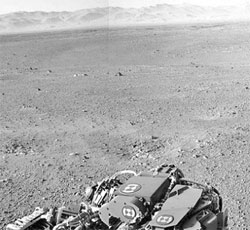Exploring the final frontier
 For something that is completely and literally out of this world,
space has become a hot news topic on media worldwide. This resurgence of
interest in the final frontier is mainly due to NASA’s spectacular
success with its Mars Curiosity Rover mission. NASA and the space
community have another reason to celebrate - the Voyager 2 space probe,
now in its 35th year, is about to enter interstellar space. Here in Sri
Lanka, we are excited by news reports that a space academy is about to
be set up, apart from plans for a communications satellite by 2015. It
is certainly going to be an exciting few years ahead of us globally and
locally, in terms of space exploration. For something that is completely and literally out of this world,
space has become a hot news topic on media worldwide. This resurgence of
interest in the final frontier is mainly due to NASA’s spectacular
success with its Mars Curiosity Rover mission. NASA and the space
community have another reason to celebrate - the Voyager 2 space probe,
now in its 35th year, is about to enter interstellar space. Here in Sri
Lanka, we are excited by news reports that a space academy is about to
be set up, apart from plans for a communications satellite by 2015. It
is certainly going to be an exciting few years ahead of us globally and
locally, in terms of space exploration.
However, along with the success stories, we hear another opinion -
that the billions of dollars spent on space exploration could have been
used to fund projects that could benefit people already living on Earth.
On the face of it, this seems to be a solid argument but dig a little
deeper into the issue and one can see how flawed it is.
The first point is that we are living in space. Our planet is part of
the Solar System, which itself occupies a tiny corner of the massive
Milky Way Galaxy. One can think of Earth as a gigantic spaceship,
because we are indeed travelling through space. In fact, billions of
years from now, our galaxy will collide with the Andromeda galaxy. That
is a long, long time away, but it pays to know that we are cosmic
voyagers. Thus, we cannot afford to ignore space phenomena. Even a
massive flare on the Sun, millions of kilometres away, can a major
effect on our Earth.
Another valid point is that life on Earth may have been ‘seeded’ from
outer space. There is such evidence of the presence of seeds of life
(building blocks) on space objects such as meteorites. With the basic
chemical building blocks of life present throughout the universe, it is
unlikely that we are alone. We simply have to know whether there is life
on other planets. This is why the Curiosity Rover will look for any
signs of life on Mars, past or present.
Inventions
Most critics forget that the space programs of the US and USSR have
resulted in many inventions and other benefits that have filtered down
to mere Earthlings like us. Did you know that NASA has filed more than
6,300 patents in the US alone? From improved pacemakers to satellite
pacemakers, we owe our thanks to space scientists for a slew of
inventions that shape our lives every day. Among the other such
inventions are shock and scratch resistant spectacle lenses, memory form
mattresses, infra red ear thermometer, long distance telecommunications,
smoke detectors, cordless power tools and advanced water filters. There
is also a light-hearted but apparently true story of NASA inventing a
pen that can write even when upside down (in the weightlessness of
space) at the cost of millions of dollars whereas the Soviets simply
used a pencil instead. These examples show us that the space program has
benefited us in more ways than we think..
 The Earth is facing many challenges - overpopulation, climate change
and global warming, pollution, the food crisis and the energy crisis are
just a few. Eventually, the Earth may no longer be habitable (rest
assured, that is a long time away) and Man may have to colonise other
planets to survive and perpetuate the species. Mars has been cited as an
obvious candidate for this process called Terraformation (making another
planet Earth-like) and the universe could be dotted with more planets
that could fit the bill.This is a very long-term goal, but not without
merit. The Earth is facing many challenges - overpopulation, climate change
and global warming, pollution, the food crisis and the energy crisis are
just a few. Eventually, the Earth may no longer be habitable (rest
assured, that is a long time away) and Man may have to colonise other
planets to survive and perpetuate the species. Mars has been cited as an
obvious candidate for this process called Terraformation (making another
planet Earth-like) and the universe could be dotted with more planets
that could fit the bill.This is a very long-term goal, but not without
merit.
But one thing is certain. Our robotic space probes will be there
before us. They will boldly go where no Man is likely to set foot on for
millennia to come. The Iconic Voyager 2 spacecraft which celebrated its
35th birthday last week is one example. It is the first man-made object
to travel beyond the solar system. In case an alien life form does
indeed find the probe as it traverses the depths of space, it contains a
golden record that contains audiovisual data on Earth, the Solar System
and Mankind. NASA says it can maintain radio contact with the two
Voyager probes till 2025, when it should be well and truly in deep
space. It will be heading towards a major star 40,000 years from now.
Both Voyagers will help us learn more about the forces at work in deep
space.
Imagination
But it is Mars, the Red Planet, that will continue to stir our
imagination. Just last week, Curiosity zapped a Martian rock with a
laser beam. That would have been science fiction even a decade ago, but
it is a reality today. It was also scheduled to perform a tentative
three-metre trek as a prelude to longer excursions in the Gale crater
area. It is equipped with a myriad of cameras and equipment that will
hopefully enable it to analyse Martian soil for any signs of life. If
there is any proof that life was present at some point of time on Mars
(there is conclusive evidence for the previous presence of water), it
would be a great victory and a fundamental shift for science.
But NASA cannot get enough of Mars. It has given the go-ahead to
another Red Planet mission. InSight - short for Interior Exploration
using Seismic Investigations, Geodesy and Heat Transport - will use a
lander to understand how Mars, Earth and other rocky planets were formed
in the early days of the solar system. Planned to launch in March 2016
and reach Mars six months later, the lander would operate for 720 days
and give the Red Planet the equivalent of a doctor's physical - checking
its pulse, gauging its reflexes and taking its temperature.
These two missions will tell us a great deal more about Mars and
their data will be invaluable for planning an inevitable manned mission
and any terraformation experiment.
The US is not the only country planning further Mars probes; several
other countries are in the fray. Moreover, any manned mission could be
an international effort, considering the massive cost and logistics
involved. More probes are being planned for other planets and moons in
our solar system.
As we probe the far reaches of space through robots, we will learn
more about our origins and our destiny in the universe. Man is curious;
he wants answers for burning questions such as whether life exists
elsewhere. If our space probes can answer this vexed question while
still enriching our day-to-day lives, the money and the sacrifices made
will not be in vain.
|


